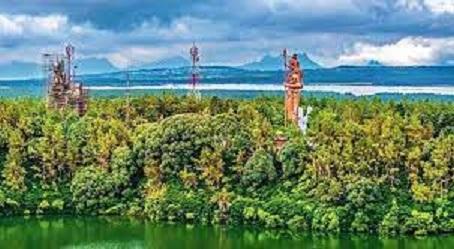Africa-Press – Mauritius. The 2nd november is an important date in the history of Mauritius because symbolically, it marks the day when the first indentured Indian labourers reached Mauritian shores.
Their arrival and the multitudes who followed in their footsteps forever altered the demography, society, economy, and politics of this small Indian Ocean island.
● Mauritius as unique In 2001, the report of the Indian Government?s High Level Committee on the Indian Diaspora mentioned: ?It would not be an exaggeration to say that among all the countries in which the Indian Diaspora is located, Mauritius must be regarded, for more than one reason, as unique and distinctive.
? There are three specific things which make the Mauritian experience unique and distinctive in the history of the Indian Diaspora in the world: the Aapravasi Ghat, Grand Bassin or the Ganga Talao, and the Indian Immigration Archives at the Mahatma Gandhi Institute.
Firstly, the Aapravasi Ghat, or ?the landing place of the immigrants?, is a spot where more than 400,000 Indian labourers landed and stayed during the first 48 hours after their arrival in Mauritius between 1848 and 1910. Therefore, as a monument and lieu de mémoire, it is unique in the history of the Indian Diaspora.
Secondly, there is no other place outside of India where the descendants of Indian immigrants were able to create an important place of pilgrimage such as Grand Bassin or the Ganga Talao where, annually, hundreds of thousands of Indo-Mauritians go to worship.
Thirdly, the Indian Immigration Archives at the MGI in Moka contains the biographical data of more than 450,000 Indian immigrants who came to Mauritian shores between 1834 and 1924.
In addition, more than 200,000 passport-size photographs of mostly Indian immigrants, which were taken at the Aapravasi Ghat between 1868 and 1890, are also housed at the Indian Immigration Archives.
● The genesis of immigration In 1829, a handful of Mauritian planters introduced 1100 Indian labourers to work on their sugar estates but, in general, this labour experiment proved to be a major failure and, within a few months, the labourers were repatriated to India.
However, between January 1830 and August 1834, there was a small trickle of indentured Indian labourers who came to Mauritius. But, it was only during the second half of 1834 and after, that large-scale Indian immigration to Mauritius began.
Furthermore, it is also important to mention that in February 1835, the British officially abolished slavery in Mauritius and after serving a four-year apprenticeship period, the island?s more than 60,000 apprentices were freed in March 1839.
During the second half of the 1830s and after, thousands of Mauritian apprentices left their former owners and settled in different parts of the island.
During this period, the local sugar planters began to import Indian labourers to supplement and eventually to replace the apprentice labourers to work in the island?s sugar canefields, in their homes, and in Port Louis. Between November 1834 and March 1839, almost 26,000 Indian labourers were landed on Mauritian shores.
However, immigration from the Indian subcontinent was suspended in May 1839 only to be renewed in January 1842, when it became controlled and sponsored by the British governments of India and Mauritius and a Protector of Immigrants also was appointed in Mauritius.
● The demographic revolution Between the mid-1830s and early 1860s, as Mauritius was experiencing a prolonged sugar revolution, a demographic revolution was also underway. In 1835, the Indians made up less than 4% of the colony?s total population and by 1860, they constituted more than 66% of the total population.
During the course of the second half of the nineteenth century, as many historians have pointed out, the composition of the local population of the other British sugar-producing colonies was not altered in such a dramatic way and over such a short period of time as in Mauritius.
In all between 1834 and 1924, around 450,000 Indians were brought to Mauritian shores, with around 290,000 remaining and 160,000 returning mostly to India and some even migrating to other British colonies such as Natal, Fiji, British Guyana, and Trinidad.
Therefore, Mauritius was unique among all the British colonies because it received the greatest number of Indian immigrants. ● ?The Great Morcellement Movement? During the 1840s and after, the Old Immigrants, or those who had served their five-year contracts and remained in Mauritius, had saved some money and began to settle outside the sugar estates.
They either bought or squatted on small patches of land in the rural areas and some even married ex-slave women and others settled in Port Louis. Gradually, between the 1840s and 1860s, a small rural Indian peasantry was emerging as they acquired small patches of marginal lands and became small cultivators and raised domesticated animals.
At the same time, others became small traders and hawkers. It was only really between the 1870s and 1920s, that a large and important class of rural Indian landowners began to emerge in Mauritius.
During the last thirty years of the nineteenth century, with the stagnation and gradual decline of the sugar industry, many of the sugar barons sold their marginal lands which were located on the fringes of their sugar estates to thousands of Old Indian Immigrants and a few Indian merchants and traders in what became known, according to Richard B.
Allen, an American historian, as the ?Great Morcellement Movement?. By the early 1920s, the Indo-Mauritians owned around 40% of the island?s valuable arable lands. As a result, most of them became small cultivators, many others became small-scale sugar growers, and a handful were large-scale sugar producers.
This Great Morcellement Movement of the late 1800s gave rise to a large Indian bourgeoisie and peasantry by the early 1900s which was gradually becoming involved in the island?s politics during the first half of the twentieth century.
The 2nd November is not a day of celebration, but rather a day of commemoration and of deep reflection on the arrival of the first indentured labourers, their toils and sacrifices as well as their great contribution in the making of Mauritius.
For More News And Analysis About Mauritius Follow Africa-Press







